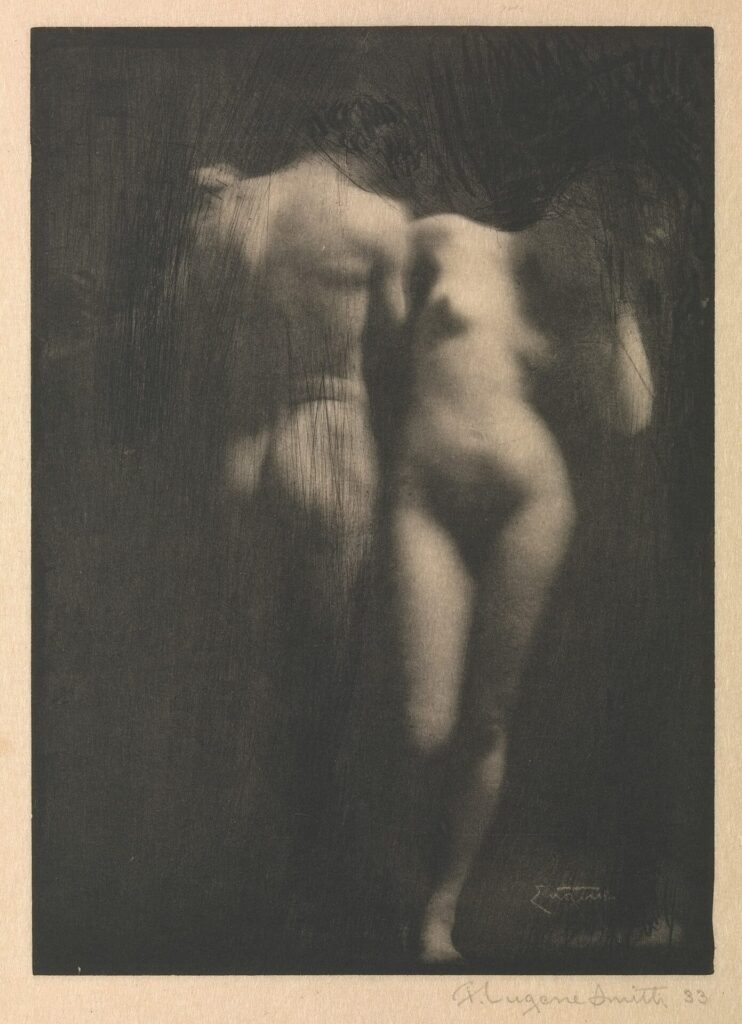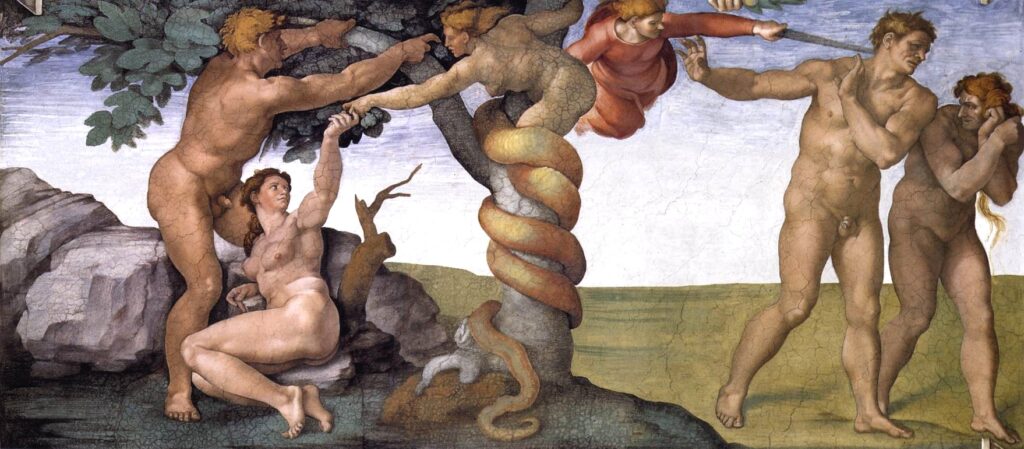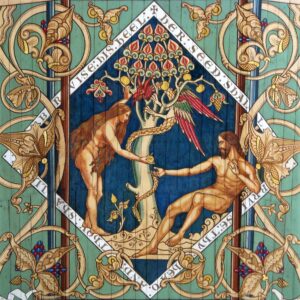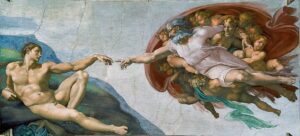Featured image: The Garden of Eden with the Fall of Man. Peter Paul Rubens, Public domain, via Wikimedia Commons.
Key Takeaways
- Theological Foundations: Original Sin originates from the biblical story of Adam and Eve’s disobedience, later formalized by Saint Augustine.
- Human Nature: It explains human imperfection and suffering as inherited from humanity’s “fall” in Eden.
- Cultural Parallels: The myth of Pandora’s Box mirrors the Genesis story, addressing similar themes of disobedience and the origins of evil.
- Moral Framework: Original Sin shapes concepts of guilt, grace, and redemption in Christian thought and Western morality.
- Cultural Influence: The doctrine has inspired centuries of art, literature, and philosophy, from Dante to Milton to modern reinterpretations.
- Universal Themes: The Fall narrative continues to resonate by addressing timeless questions about human flaws, morality, and hope for redemption.
The concept of Original Sin occupies a unique place in Christian Mythology. Though it first arose in a religious context, its influence has rippled far into moral philosophy, culture, politics, and art. At its core, Original Sin seeks to address why human existence is fraught with moral tension, pain, and the inclination toward wrongdoing. It draws on the biblical story of Adam and Eve’s transgression, proposing that this ancient act continues to shape every generation that follows.
For centuries, thinkers have wrestled with the implications of this narrative. Some have emphasized the burden of guilt that humanity allegedly inherits. Others have highlighted the grace and redemption promised through Christian teachings. Still others have critiqued or reworked the idea to align with evolving understandings of biology, ethics, and society. Throughout these diverse interpretations, Original Sin has remained a recurring theme, frequently revisited in religious sermons, theological scholarship, artistic masterpieces, literary epics, and modern media.
This article explores the broad tapestry of thought surrounding Original Sin. It traces the origins of the doctrine in biblical texts, examines its development through the lens of influential theologians, and surveys its impact on moral frameworks, philosophical debates, and cultural representations. It also addresses contemporary criticisms, including scientific and humanistic perspectives, and considers how the concept still resonates in modern discussions about human flaws and aspirations.
Table of Contents
Theological Foundations of Original Sin
The Garden of Eden Narrative
The story most closely associated with Original Sin appears in the Book of Genesis (chapters 2–3). Here, God creates Adam and Eve and places them in the lush setting known as the Garden of Eden, where they have access to abundant resources and a life free from toil. Yet, they are forbidden to eat from the Tree of the Knowledge of Good and Evil.
The turning point unfolds when a serpent—commonly viewed as a trickster figure—convinces Eve to take the fruit from the forbidden tree. She shares it with Adam, who also eats. Their sudden awareness of their nakedness symbolizes a profound shift: innocence is lost, shame appears, and divine displeasure ensues. God expels them from the garden, imposing curses on the serpent, Adam, and Eve. Childbearing becomes painful, labor becomes taxing, and the ground itself is cursed.
Within the biblical text, the direct inheritance of guilt or sin by subsequent generations is not spelled out in strong detail. The immediate punishments fall on Adam and Eve themselves, although the notion of a broad consequence for all humanity emerges later in Christian thought. In the Genesis account, the scene underscores the themes of disobedience, moral knowledge, and alienation from divine presence.
Early Interpretations and Ambiguities
In early Jewish traditions, the story of Adam and Eve was read primarily as an account of humanity’s first moral failing or as an allegory on why suffering and hardship exist. Rabbinic teachings often reflect on the lessons of obedience rather than a permanent, inherited guilt. Over time, various thinkers, including early Christian writers, began to link Adam’s sin to the universal condition of wrongdoing and mortality.
A key ambiguity in Genesis lies in whether Adam and Eve’s misdeed becomes a spiritual burden for their descendants or serves more as a cautionary tale about the consequences of disobeying divine commands. This ambiguity would later inspire theologians—most notably Saint Augustine of Hippo—to develop more systematic doctrines, weaving the Eden story into a broader theological narrative about humanity’s moral depravity and need for redemption.

Doctrine in Christian Theology
Saint Augustine’s Formulation
Among the many figures who shaped Christian ideas, Saint Augustine of Hippo (354–430 CE) stands out as the architect of the doctrine of Original Sin in Western Christianity. Influenced by the biblical passages of Romans 5:12–21, Augustine reasoned that Adam’s disobedience introduced a universal corruption of human nature. This corruption, he argued, is transmitted through procreation, rendering every child born into a condition of inherent sinfulness.
Central to Augustine’s argument is the idea that all people share in Adam’s guilt. He described this moral flaw as an internal tendency toward selfishness, a distortion in human desires—termed concupiscence. In his debates with Pelagius, who believed that humans were born innocent and capable of achieving righteousness without divine intervention, Augustine emphasized humanity’s utter reliance on God’s grace for salvation. In his view, baptism was critical for cleansing the guilt inherited from Adam and for granting entry into a state of grace.
Eastern Orthodox Views
While Augustine’s formulation dominated Western theology, the Eastern Orthodox branch of Christianity took a somewhat different path. In Orthodox thought, there is acknowledgment that Adam’s disobedience introduced corruption, suffering, and mortality into the human experience. However, the Orthodox tradition speaks of “ancestral sin,” which highlights the consequences of Adam’s action rather than personal guilt for his trespass. Individuals inherit mortality and a weakened state, but they do not carry the burden of Adam’s personal guilt. Salvation, in Orthodox theology, is understood as a process of deification—a transformative journey in which humanity gradually overcomes its fallen condition through participation in divine grace.
The Reformation Perspective
The doctrine of Original Sin gained renewed focus during the Protestant Reformation of the 16th century. Martin Luther embraced the Augustinian view that humanity was profoundly corrupted and utterly dependent on God’s grace. He believed that no human effort could bridge the gulf created by sin, placing a heavy emphasis on faith alone (sola fide). John Calvin expanded on this, introducing the concept of total depravity, claiming that every aspect of human nature was tainted by sin. These views underscored the idea that salvation is an undeserved gift from God, not the result of moral striving.
The Reformation debates brought further attention to questions of free will, predestination, and the justness of inheriting guilt. While Luther and Calvin used Augustine’s teachings as a foundation, they also adapted them to address the pressing theological and political tensions of their time. Their positions would shape large segments of Protestant theology, reinforcing Original Sin as a central explanation for humanity’s moral predicament.
Moral and Philosophical Dimensions
The Human Condition and the Problem of Evil
One of the most pressing philosophical questions across cultures concerns the existence of evil: why is the world filled with suffering and wrongdoing? The doctrine of Original Sin provides an answer grounded in the moral failing of humanity’s earliest ancestors. In Augustine’s theology, God is not responsible for creating sin; rather, sin enters the world through the free actions of Adam and Eve. Evil is thus understood as a distortion of good, stemming from disobedience.
By placing responsibility for suffering at the feet of humanity’s misused free will, the doctrine addresses a fundamental concern in monotheistic traditions: reconciling God’s goodness and omnipotence with a reality where calamity and malevolence persist. In this view, tragedy and moral failures do not indicate flaws in the divine but reflect humanity’s self-imposed exile from grace.
Moral Implications and the Role of Grace
The concept of Original Sin underscores a moral framework that stresses humility and repentance. If humans are tainted from birth with a propensity for selfishness, then moral life becomes a constant battle between corrupted desires and the call to righteousness. Practitioners are encouraged to seek divine assistance to overcome these ingrained faults.
- Personal Guilt and Repentance
The doctrine fosters an intense focus on personal guilt and the process of seeking forgiveness. Through confession, prayer, and acts of penance, believers strive to realign themselves with a holy standard. The frequent emphasis on self-reflection can promote moral vigilance but may also produce emotional burdens, including shame and a sense of unworthiness. - Dependence on Divine Assistance
Augustine and later Reformers stressed that human initiative is inadequate to fully atone for sin. Divine grace becomes the decisive force that enables individuals to break free from corrupt inclinations. This tension—between human responsibility for wrongdoing and reliance on God’s mercy—remains a central theme in many Christian traditions. - Social Ethics
In broader social contexts, Original Sin can promote cautious attitudes regarding institutions and governments, reflecting the belief that all human systems are prone to corruption. This idea has influenced political theories that favor checks and balances. In addition, some perspectives highlight empathy and compassion, arguing that if everyone shares in a flawed condition, no one is beyond redemption or unworthy of help.
Philosophical Engagements with Human Nature
Beyond theology, philosophers have engaged with the concept of innate human imperfection in varied ways:
- Thomas Hobbes (1588–1679) depicted life in the absence of societal constraints as violent and chaotic, reflecting a pessimistic view of human nature not dissimilar to the Augustinian perspective. For Hobbes, strong governmental structures became essential to restrain these darker impulses.
- Jean-Jacques Rousseau (1712–1778) challenged the idea of inherent moral failure, claiming humans are born good but corrupted by social structures. While Rousseau did not formulate his views as a direct response to Original Sin, his stance offers a stark contrast, shifting responsibility from a primal failing to external factors.
- Friedrich Nietzsche (1844–1900) criticized Christianity’s emphasis on guilt and humility, suggesting that it stifled human potential. He framed Original Sin as a tool for social control, discouraging self-affirmation.
In the modern era, thinkers have debated whether inherited wrongdoing is compatible with concepts like free will, individual responsibility, and social progress. Some integrate psychological models to explain guilt and shame, while others suggest that moral flaws arise from evolutionary or cultural factors rather than a metaphysical fall.
Cultural Impact in Art, Literature, and Philosophy
Visual Art and the Fall
The motif of Adam and Eve’s transgression has inspired visual artists from late antiquity to modern times. These depictions often emphasize the moment of temptation—the serpent winding through the Tree of Knowledge as Eve extends the fruit to Adam.
- Early Christian and Medieval Art
Frescoes, mosaics, and illuminated manuscripts featured stylized images of the Eden narrative. The focus lay on instructing believers about the dire consequences of disobedience. Illustrations might portray Adam and Eve clothed in simple tunics after the Fall or show an angel driving them out of paradise. - Renaissance Masterpieces
During the Renaissance, artists like Michelangelo and Albrecht Dürer explored the Fall with a heightened sense of anatomical realism. Michelangelo’s Sistine Chapel ceiling places the story within a grand sweep of biblical history, while Dürer’s engraving Adam and Eve combines classical ideals of beauty with detailed symbolism, highlighting the vulnerability and grandeur of humanity. - Symbolic and Surreal Interpretations
Later artists, such as Hieronymus Bosch, used the Eden narrative as a springboard to depict moral chaos and the grotesque consequences of sin. Bosch’s The Garden of Earthly Delights contrasts the paradise of Eden with scenes of indulgence and torment, suggesting that Adam and Eve’s single act foreshadowed endless moral complexity. - Modern and Contemporary Art
Today, the Eden story is sometimes reimagined to question gender roles, power structures, and cultural norms. Contemporary works may focus on Eve’s agency rather than her blame, or interpret the fruit as a symbol of self-awareness and liberation. These reinterpretations reflect ongoing debates about how Original Sin narratives influence societal attitudes toward women, sexuality, and individual autonomy.
Literary Expressions of Adam and Eve’s Disobedience
Literature has also played a key role in sustaining and reshaping the concept of Original Sin:
- John Milton’s Paradise Lost (1667)
This English epic poem offers one of the most elaborate artistic explorations of the Fall. Milton dramatizes the temptation scene and delves into the inner thoughts of Adam, Eve, and even Satan. The poem touches on issues of free will, divine justice, and love. In describing the Fall as a “fortunate fall” (felix culpa), Milton suggests that humankind’s redemption through Christ is made possible by Adam’s original mistake. - Dante Alighieri’s Divine Comedy (1308–1320)
Although Dante’s work does not center on Adam and Eve in great detail, the broader notion of inherited sin colors his journey through Hell, Purgatory, and Paradise. The entire cosmic vision presupposes that humanity is burdened by wrongdoing but can still aspire to redemption. - Modern Novels and Short Stories
Authors have reworked Edenic imagery to speak about guilt, temptation, and human frailty in new contexts. For instance, in dystopian narratives, technological arrogance may replace forbidden fruit, while psychological novels sometimes use the motif to examine how individuals grapple with inherited flaws. - The Fall as Metaphor
In many contemporary pieces, the Fall functions as a metaphor for personal awakening or social critique. Writers may reposition Adam and Eve’s transgression as the first step in human consciousness, echoing a modern interpretation that views the fruit not as a moral failing but as a necessary journey into awareness and selfhood.
Philosophical and Psychoanalytic Reflections
- Freudian Parallels
Sigmund Freud’s psychoanalytic framework proposed that individuals wrestle with hidden desires and suppressed guilt. While not a direct restatement of Original Sin, Freud’s model of the psyche parallels the idea of a fundamental inner conflict that shapes thoughts and actions. The concept of a latent force compelling wrongdoing resonates with Augustine’s view of concupiscence. - Jung and Individuation
Carl Jung offered a different approach by framing the Eden narrative as symbolic of the development of consciousness. In his view, the movement from innocence to knowledge is an inevitable stage of human growth. The Eden account can thus be read as describing the psychological transition from unexamined unity to individual self-awareness. - Nietzsche’s Critique
As mentioned, Nietzsche challenged the entire moral system that Original Sin represented. He viewed the emphasis on guilt as life-denying, replacing what he saw as humanity’s inherent creativity and power with a culture of submission. His critique aimed to free individuals from what he considered repressive moral codes.

Contemporary Challenges and Reinterpretations
Scientific Critiques
Evolutionary biology challenges a literal reading of Adam and Eve as the progenitors of all humanity. If humans share common ancestors with other species, there is no single moment when sin entered through a single act of disobedience. Genetic research further complicates the idea of inheriting a moral flaw in a biological sense.
In response, some theologians interpret the Eden narrative as a symbolic account of humanity’s moral awakening. They argue that Original Sin refers to the universal human propensity for wrongdoing—an anthropological reality—rather than a direct biological transmission.
Humanistic and Existential Perspectives
Secular philosophies often present alternative explanations for human nature’s contradictory impulses. Rather than attributing wrongdoing to an ancestral fall, these perspectives might emphasize social conditioning, psychological forces, or existential freedom:
- Humanistic Optimism
Thinkers like Jean-Jacques Rousseau and more modern advocates of human potential hold that people start with a largely good or neutral disposition and that social systems or lack of education breed corruption. This stands apart from Augustine’s pessimism, shifting moral responsibility from inherited sin to flawed institutions or personal choices. - Existentialist Views
Jean-Paul Sartre considered individuals “condemned to be free,” tasked with making ethical choices in an apparently indifferent universe. In this sense, human failings stem from the weight of freedom rather than a transmitted guilt. Albert Camus explored absurdity and the struggle for meaning, again casting human vulnerability in terms distant from inherited sin. - Freudian and Jungian Models
Sigmund Freud’s concept of the unconscious deals with primal drives, guilt, and the role of cultural taboos, which can mirror the moral tension described by Original Sin. Carl Jung reframed biblical symbolism in psychological terms, seeing the Eden story as a universal passage from unknowing innocence to the complexities of conscious life.
Modern Theological Developments
Contemporary Christian theologians have sought to reconcile the doctrine with advances in science and societal shifts:
- Symbolic Interpretations
Many now view Adam and Eve’s story not as a literal historical event but as a potent illustration of humanity’s universal inclination to make harmful choices. The Fall becomes a metaphor for the profound reality that people often fail to live up to moral ideals. - Focus on Collective Responsibility
Others reinterpret Original Sin to address collective structures of injustice. Here, sin includes systemic actions perpetuated by societies, echoing the Edenic theme of alienation. This approach underscores the need for communal transformation and solidarity. - Ecological and Cosmic Dimensions
With growing concern about environmental crises, some theologians apply the concept of Original Sin to humanity’s exploitation of nature. By turning away from harmony with creation, humans have caused harm on a global scale, reminiscent of the disordered state that followed Adam and Eve’s disobedience.
Conclusion
Original Sin remains one of the most consequential doctrines within Christian Mythology, reflecting centuries of exploration into humanity’s moral dilemmas. Beginning with the Genesis account of Adam and Eve, it crystallized in Augustine’s writings as a far-reaching explanation for why individuals battle internal desires and why societies can be deeply flawed. Augustine’s emphasis on inherited guilt and the absolute necessity of divine grace resonated through medieval Christendom, informed Reformers like Martin Luther and John Calvin, and shaped Western culture’s general outlook on wrongdoing and redemption.
Artists, poets, and philosophers across time have reinterpreted the narrative to highlight distinct dimensions of the human condition. Visual representations range from medieval mosaics warning against disobedience to Renaissance masterpieces capturing the dignity and frailty of the first couple, culminating in modern and contemporary art that questions or redefines the meaning of the Fall. Literature has produced iconic treatments of the topic, as seen in Milton’s Paradise Lost or Dante’s Divine Comedy, weaving moral, theological, and existential layers into the Eden story.
In modern contexts, the doctrine faces fresh challenges. Scientific advances question the feasibility of a single ancestral event, while humanistic and existential philosophies offer alternate accounts of moral failings. Nonetheless, the underlying questions that Original Sin addresses—why do people cause harm, why is suffering so pervasive, and how can we correct our course—remain as pressing as ever. Even critics who reject the notion of inherited guilt still grapple with the moral realities the doctrine was designed to explain.
Furthermore, the Eden narrative endures as a cultural symbol. It shapes discussions of personal guilt, fosters debates on societal injustices, and surfaces in pop culture’s recurring fascination with stories of fall and redemption. Whether regarded as a literal historical claim, a metaphorical depiction of humanity’s universal struggle, or an outdated relic that modern insights must supersede, Original Sin continues to spark conversation. In the process, it encourages reflection on the perpetual tension between human aspiration and human limitation, reminding us of the complex tapestry that is our moral life.
This lasting influence underscores why Original Sin remains a potent lens for examining the human experience. It offers a cautionary tale about free will and disobedience, a powerful impetus for introspection and humility, and a platform for reflecting on how we might address the problems that arise from our collective shortcomings. In this way, the ancient narrative of Adam and Eve continues to resonate, testifying to the enduring power of mythic stories in shaping cultural and personal understandings of right, wrong, and the search for a redemptive path forward.




